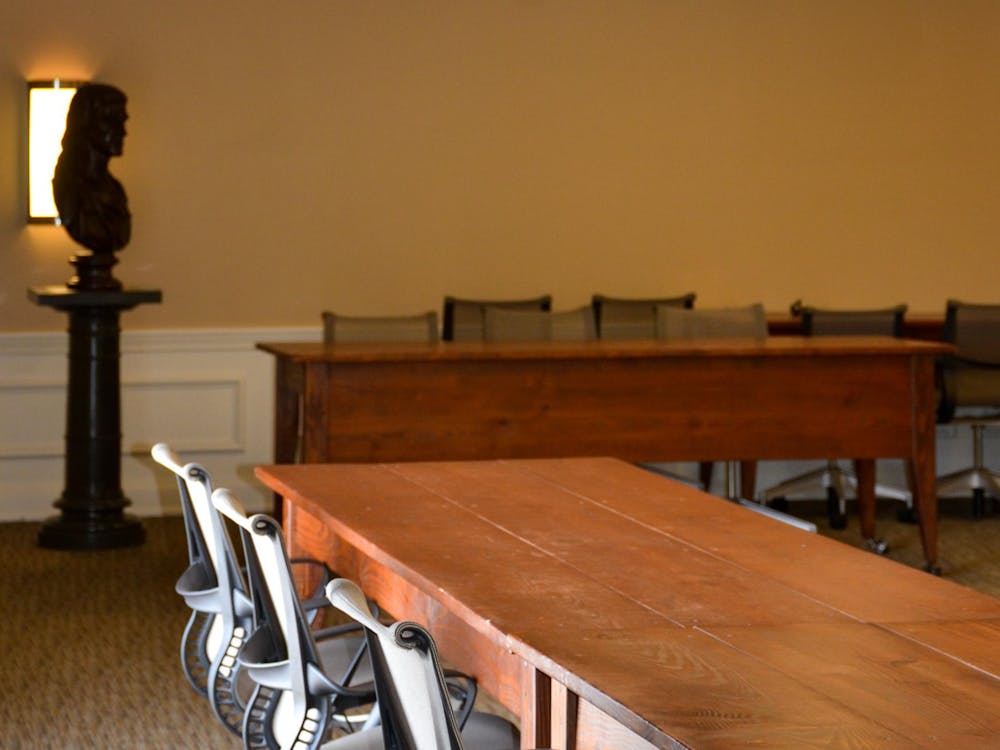Lawn selection, one of the University's most time-honored traditions, was recently completed, but not without some students expressing concern that the process is less than perfect.
After evaluating the 272 applications submitted this year, the Lawn selection committee released the list of 47 third-year students chosen for the 181st class of Lawn residents last week.
Forty-seven students are chosen every year for the Lawn by a selection committee made up of 35 students, 20 Ex-Officio members, students who represent a specific portion of the University population, and 15 lottery members, fourth-year students who apply and are chosen at random. Third-years had until Jan. 20 to complete applications, which consisted of three parts: personal information, University achievements and awards, and two essay questions.
Process
Beginning in the fall of every year, Lawn selection is an intensive process that takes more than two months to complete. First, the Lawn selection process organizing committee meets to decide the details of that year's selection. Ten of the Ex-Officio members make up the organizing committee -- representatives from each of the six school councils, Student Council, the Honor and University Judiciary Committees, the current Head Resident of the Lawn and three faculty and staff members, Newcomb Hall Director Bill Ashby, Dean of Students Penny Rue, and John R. Evans, director of accommodations for housing.
"The organizing committee convenes and looks at the applications to see if they want to make any changes, looks at the criteria for changes and promotes the process," Rue said.
The first set of applications is for current fourth-years who want to be on the selection committee. In previous years, this application included essay questions concerning why the student wanted to participate in the selections process. In the past few years, the organizing committee chose to eliminate the essay portion and instead use a randomized lottery to pick the members.
"Basically what we wanted to do was combat the perception that Lawn selection is an inside job," Rue said. "The only people who would really bother to write out an entire essay would be people on the Lawn or those who had a significant interest. This way there's a much broader ownership of the process. It's everybody's Lawn and all that's really required is a willingness to give time to it."
In 2002, a special committee revised the process to further reduce the belief that Lawn selection engages in favoritism practices. Prior to these changes, the committee consisted of the 10 Ex-Officio and 25 lottery members. The special committee altered the distribution of seats, changing 10 of the lottery spots to Ex-Officio ones in the hopes that having a more diverse group of representatives would expand the Lawn to all areas of the University community.
The Lawn selection committee now includes the Inter-Fraternity and Inter-Sorority Council presidents, representatives from the Black Student Alliance, the Asian Student Union and the Queer Student Union, a transfer student, a student athlete, an international student, a Middle Eastern student and a Hispanic student representative. Each organization has a separate process for choosing its representative.
"Since the committee picks students, it needs to represent a wide variety of clubs and different backgrounds," said Mariam Haladjian, a fourth-year College student and transfer student committee member. "The committee is diverse enough so that it can represent the community as a whole."
Rounding out the 35 committee members, Housing and the head resident conducted a lottery where numbers were assigned to each applicant, and 15 of them were randomly selected.
After Winter Break, the selection committee begins its work. Aside from a minimum 2.0 GPA, there are no specific guidelines for choosing Lawn residents. The committee members have two weeks to read through all 272 applications and select the 47 he or she felt most representative of the ideal Lawn resident.
"The criteria varies from person to person within the committee," Haladjian said. "We were given basic guidelines and then it was up to us to decide how to weigh the extracurricular activities and academics."
This year, the process was conducted entirely online. Rather than being sequestered in the conference room of Page House to read paper copies of the application, committee members could access the applications by logging into a computer system similar to Toolkit.
The online system "worked great," said Su Htay, fourth-year Engineering student and committee member. "This is much more convenient, and the people who manage the Web site make it very easy to use."
But the new process did have some drawbacks, especially in the strict character limit for essays imposed on applicants.
"It was kind of difficult because of the character limit which even counts spaces," said Tom Stephansky, a third-year College student and Lawn alternate. "It's hard to talk about what you've done for the University when there's a character limit. You really have to think about what to include."
Using the online system, committee members have access to the transcripts, essays and achievement section on the applications, but all personal information is redacted and applicants are identified only by their social security number. At the end of the week, each committee member submits a list of 47 candidates to the head resident.
The numbers are entered into an Excel spreadsheet, which ranks the applicants according to the number of votes received. After the first phase, committee members re-read selected applications and vote on tie-breakers until there are a definite 47. The selected applicants are then notified by Housing.
Confidentiality
Before the selections process begins, committee members are required to sign a confidentiality agreement promising not to divulge information about the applications. The agreement states committee members pledge "not [to] share any information about applicants with anyone outside of the Committee." According to Rue, the purpose of the policy is to protect personal information on the applications and transcripts.
"It should be an individual's decision to make [their candidacy] public or not," she said.
Members of the committee, however, interpret the policy to differing levels of secrecy, some going as far as refusing to talk about the process at all.
This lack of transparency has lead some students to question how the process is conducted.
"I didn't feel like it was very well run," said Chris Miles, a third-year College student who was rejected from the Lawn. "They never really make clear what they're looking for. I'm not just saying that because I didn't get on, but a lot of other qualified individuals who I know didn't, so it's disappointing. The whole idea of the Lawn is that it's so visible and supposed to be an honor in the community. And if it's supposed to be an honor, I don't know why it's such a big secret who got on and who's doing the selecting."
Mary O'Connell, a fourth-year Engineering student and Hispanic representative to the selection committee, said she also believes the process should be more open.
"I think it's much better to have transparency," she said. "I do believe in keeping the secrecy of individual applications, because people tend to be very honest in their essays. But the process should be more open so third years know how it works. It's important that the people who get on, and the people who don't, understand the process so they don't feel slighted."
Third-year College student Catherine Neale, who was accepted to the Lawn for next year, said she agrees that making the process less ambiguous would help it improve.
"I think the problem is more that you don't really know what [the committee] is looking for in a Lawn resident," Neale said. "The confidentiality of the actual process is fine -- they just need to make clear what they're actually looking for."
Head Resident Abra Tabak declined to comment for this article.






